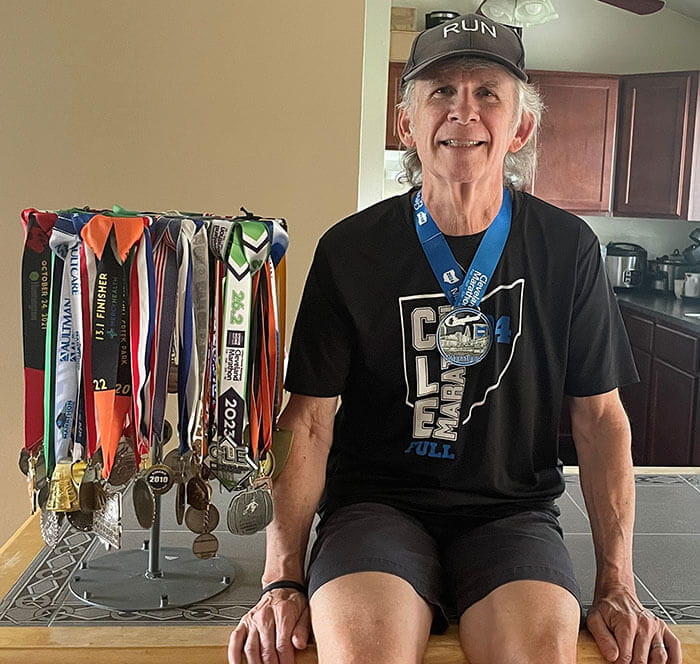Elite Runner and Heart Attack Survivor Completes 10K Six Months Later, Aided by Sports Cardiologist at University Hospitals Harrington Heart & Vascular Institute
May 06, 2025
Innovations in Cardiovascular Medicine & Surgery | May 2025
When 66-year-old John Zack suffered a ST-elevated myocardial infarction (STEMI) while running the Cleveland Marathon – his eighth 26.2-mile race – the “chain of survival” established by event medicine and emergency medicine at University Hospitals (UH) saved his life. After being treated in the medical tent, a cardiac catheterization, drug eluting coronary stent and short hospital stay followed, and Zack was on his way.
 Bradley Lander, MD
Bradley Lander, MDHowever, Zack’s care at UH did not end there. Determined to maintain his status as an elite runner, he sought the expertise of Bradley Lander, MD, Director of the Sports Cardiology Center at UH Harrington Heart & Vascular Institute.
“I met him afterwards because the question came up of coronary artery disease in an elite athlete, and questions regarding the safety and best way to return to play,” Dr. Lander says.
Dr. Lander did a comprehensive review of Zack’s cardiac health, including an echocardiogram and an advanced cardiopulmonary exercise test to measure various metabolic and cardiac parameters to help guide a return to competition. He also prescribed cardiac rehab for Zack – which the active runner wasn’t sure he wanted or needed. But Dr. Lander says it’s an essential part of “return to play.”
 UH Sports Cardiology patient John Zack.
UH Sports Cardiology patient John Zack.
“I always recommend a trial of cardiac rehab, even in elite athletes, because we can monitor them very carefully for essentially several months while they're doing enjoyable exercise,” he says. “I have had a 100% satisfaction rate with cardiac rehab based on patient feedback, even in several of the extremely high-level athletes that I've sent there.”
Zack’s results speak for themselves. After suffering a heart attack on May 19, 2024, he ran a 10K on Nov. 16, 2024 – just six months later.
“He eventually successfully ran the 10K with no issue and has been doing great for essentially almost a year,” Dr. Lander says. “He's on all the usual guideline-directed medical therapy for heart attacks. I try to treat these patients using the gold standard medical therapy, but by finding ways that still allow them to exercise at a high level.”
Of Note
Dr. Lander’s patient-centered approach is consistent with updated guidelines from the American Heart Association and American College of Cardiology on clinical considerations for competitive sports participation for athletes with cardiovascular abnormalities.
“The guidelines have shifted more towards shared decision-making and risk assessment,” he says. “The important thing is involving patients and understanding their values.”
Zack’s case, Dr. Lander says, helps illustrate the myth that elite athletes are somehow immune to heart disease.
“More recent data have shown that's not true,” he says. “People have other risk factors. And while exercise may lower the risk, it doesn't completely eliminate the risk. There's also this notion that if you have significant heart disease, you cannot participate in high level athletics or competitive sports. Historically, the guidelines have been somewhat paternalistic and not necessarily data driven. But over the past five to 10 years, there have been more studies that have shown that for individuals with significant cardiac disease, it may be safe for them to return to high level athletics.”
Dr. Lander says Zack’s case also provides a positive message for others who have suffered a heart attack – but aren’t elite athletes.
“For recreational exercisers who want to be more active, if they're looking to get into walking programs or doing their first 5K, it's a lot easier to get those people back into that type of exercise or get them into that exercise for the first time,” he says. “If they're interested, they should be risk-stratified and undergo shared decision-making with a sports cardiology expert.”
Contributing ExpertBradley Lander, MD
Director, Sports Cardiology Center
University Hospitals Harrington Heart & Vascular Institute
Assistant Professor
Case Western Reserve University School of Medicine


